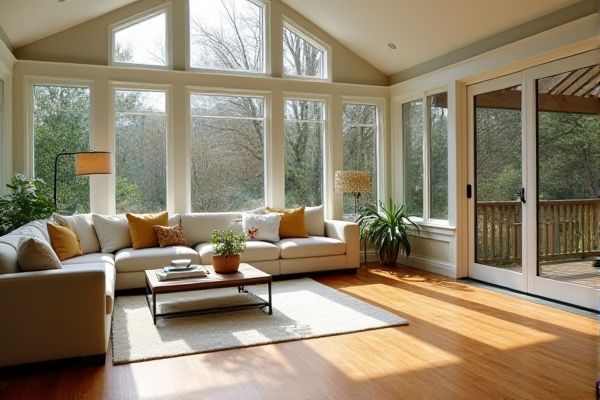
Hardwood flooring offers natural beauty and durability, but engineered wood is more resistant to humidity and temperature fluctuations, making it ideal for sunrooms. Discover which flooring option best fits your sunroom needs by exploring the full article.
Table of Comparison
| Feature | Hardwood Flooring | Engineered Wood (Sunroom) |
|---|---|---|
| Material Composition | Solid natural wood | Top layer of real wood veneer over plywood |
| Moisture Resistance | Low - prone to warping in humid conditions | High - better stability in sunroom humidity and temperature changes |
| Durability | Highly durable with proper maintenance | Durable, but top veneer is thinner and limits refinishing |
| Installation | Nailed or stapled to subfloor | Floating, glue-down, or nail-down options |
| Cost | Higher initial cost | More cost-effective alternative |
| Appearance | Natural wood grain, ages gracefully | Real wood look, consistent appearance |
| Suitability for Sunrooms | Not ideal due to moisture fluctuations | Recommended for sunrooms due to moisture and temperature resistance |
| Lifespan | 20-100 years with refinishing | 15-30 years, limited refinishing |
Understanding Hardwood Flooring: Core Features
Hardwood flooring offers durability, natural beauty, and the ability to be refinished multiple times, making it a long-lasting choice for sunrooms with controlled humidity. Engineered wood consists of a hardwood veneer over plywood layers, providing greater moisture resistance and dimensional stability ideal for sunrooms exposed to temperature fluctuations. Your decision should balance hardwood's classic appeal with engineered wood's enhanced performance in sunroom environments.
Engineered Wood: Structure and Benefits
Engineered wood flooring consists of multiple layers of plywood topped with a hardwood veneer, providing enhanced stability and resistance to moisture compared to traditional hardwood. This multilayer construction minimizes warping and expansion, making it ideal for sunrooms where temperature and humidity levels fluctuate. Engineered wood offers the natural beauty of hardwood while maintaining durability in environments prone to sun exposure and humidity changes.
Sunroom Flooring: Key Considerations
Sunroom flooring requires materials that withstand temperature fluctuations and humidity changes; hardwood flooring offers natural beauty but can warp in such conditions. Engineered wood, constructed with a plywood base and real hardwood veneer, provides superior dimensional stability ideal for sunrooms. Moisture resistance and durability make engineered wood the preferred choice for sunroom environments, ensuring longevity and maintaining aesthetic appeal.
Moisture Resistance in Sunroom Environments
Engineered wood flooring offers superior moisture resistance compared to hardwood flooring, making it more suitable for sunroom environments where humidity and temperature fluctuations are common. The layered construction of engineered wood, with a plywood or high-density fiberboard core, provides enhanced stability against warping and swelling caused by moisture. Hardwood flooring, being solid wood, is more prone to expansion and contraction in humid conditions, which can lead to gaps or cupping in sunrooms exposed to varying weather.
Durability: Hardwood vs Engineered Wood
Hardwood flooring offers superior durability with its solid, thick planks that can be sanded and refinished multiple times, making it ideal for high-traffic areas. Engineered wood features a plywood core with a hardwood veneer, providing enhanced resistance to moisture and temperature fluctuations common in sunrooms. While hardwood is prone to warping in humid conditions, engineered wood maintains stability, extending its lifespan in sunroom environments.
Installation Methods: Comparison and Suitability
Hardwood flooring typically requires a nail-down or staple installation method, making it ideal for areas with stable subfloors like indoors but less suitable for sunrooms due to potential moisture and temperature fluctuations. Engineered wood features a click-lock or glue-down installation, providing enhanced stability and resistance to humidity, which makes it more appropriate for sunroom environments. The multilayer construction of engineered wood allows it to withstand expansion and contraction better than solid hardwood, ensuring durability in sunroom conditions.
Aesthetic Differences: Natural Looks and Finishes
Hardwood flooring in sunrooms provides a rich, authentic appearance with unique grain patterns and natural color variations that enhance the space's warmth and character. Engineered wood offers a consistent finish with a top layer of genuine hardwood, allowing for durable, moisture-resistant surfaces ideal for sunroom environments. Both options deliver timeless aesthetics, but hardwood emphasizes natural beauty while engineered wood balances appearance with practical performance.
Maintenance and Longevity in Sunrooms
Hardwood flooring in sunrooms requires regular sealing and careful humidity control to prevent warping and discoloration from sunlight exposure, ensuring its long-term durability. Engineered wood offers superior stability in fluctuating temperatures and moisture levels typical of sunrooms, reducing maintenance needs and extending lifespan. Both options benefit from UV-resistant finishes to maintain appearance, but engineered wood generally outperforms hardwood in sunroom longevity due to its multi-layer construction.
Cost Analysis: Initial Investment and Long-Term Value
Hardwood flooring typically involves a higher initial investment due to the cost of solid wood planks and professional installation, making it a premium choice for your sunroom. Engineered wood offers a more budget-friendly upfront cost while providing similar aesthetic appeal and improved moisture resistance, enhancing its long-term durability in sunroom environments. Considering maintenance and resale value, hardwood flooring can deliver greater long-term value despite the higher initial expense, thanks to its durability and ability to be refinished multiple times.
Best Flooring Choice for Your Sunroom
Hardwood flooring provides natural beauty and durability but is susceptible to moisture and temperature fluctuations commonly found in sunrooms, which can cause warping or cupping. Engineered wood offers enhanced stability with a layered construction designed to withstand humidity and temperature changes, making it a more practical choice for sunroom environments. Selecting engineered wood ensures long-lasting performance while maintaining the aesthetic appeal of real wood in sunrooms.
 homyna.com
homyna.com